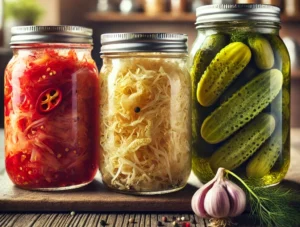

Understanding the Basics of Fermentation
- The Role of Salt
Salt is essential for fermentation as it:- Inhibits harmful bacteria while allowing beneficial microbes to thrive.
- Draws water out of the vegetables, creating a brine that protects against spoilage.
Best Salt for Fermentation: Use non-iodized salts like sea salt, Himalayan pink salt, or kosher salt. Avoid table salt with iodine or anti-caking agents, as these can interfere with fermentation.
- The Role of Water
Chlorine and other chemicals in tap water can hinder the fermentation process.- Best Water for Fermentation: Use filtered or distilled water. If using tap water, boil it and let it cool to remove chlorine, or let it sit uncovered for 24 hours.
- Equipment Needed
- Mason jars or fermentation crocks.
- Weights to keep vegetables submerged (glass weights or a smaller jar can work).
- Cheesecloth or an airlock lid to allow gases to escape while keeping contaminants out.
Recipe 1: How to Make Kimchi
Ingredients:
- 1 medium Napa cabbage (about 2 lbs)
- 1/4 cup non-iodized salt
- 4 cups filtered water
- 1 tablespoon grated ginger
- 4 garlic cloves, minced
- 2 tablespoons fish sauce (optional)
- 1-2 tablespoons Korean chili flakes (gochugaru)
- 1 teaspoon sugar
- 3 green onions, sliced
- 1 medium carrot, julienned
- 1 small daikon radish, julienned
Instructions:
- Prepare the Cabbage:
- Slice the Napa cabbage into quarters and then into bite-sized pieces.
- Dissolve the salt in water to make a brine. Submerge the cabbage and let it soak for 1-2 hours, turning occasionally.
- Rinse the cabbage thoroughly to remove excess salt.
- Make the Paste:
- Combine ginger, garlic, fish sauce, chili flakes, and sugar in a bowl to create a paste.
- Mix and Pack:
- Mix the paste with the cabbage, green onions, carrot, and daikon. Massage the mixture with your hands until the vegetables are coated.
- Pack the mixture tightly into a jar, leaving about 1 inch of headspace. Press down to release brine.
- Ferment:
- Cover the jar with a cheesecloth or loosely screw on the lid. Place it in a cool, dark area (60-75°F) for 3-7 days.
- Check daily, pressing down the mixture to keep it submerged in brine.
- Taste and Store:
- Once the desired flavor is reached, transfer the jar to the refrigerator, where it will keep for several months.
Recipe 2: How to Make Sauerkraut
Ingredients:
- 1 medium green cabbage (about 2 lbs)
- 1 tablespoon non-iodized salt
Instructions:
- Prepare the Cabbage:
- Remove the outer leaves and set one aside.
- Finely shred the cabbage and place it in a large mixing bowl.
- Salt the Cabbage:
- Sprinkle salt over the shredded cabbage. Massage vigorously with your hands until the cabbage releases enough liquid to create a brine (about 5-10 minutes).
- Pack and Weigh Down:
- Pack the cabbage tightly into a jar or crock, pressing down firmly to submerge it in its brine.
- Place the reserved cabbage leaf on top as a barrier, then weigh it down with a glass weight or smaller jar.
- Ferment:
- Cover the jar with a cheesecloth or airlock lid. Leave it in a cool, dark place (65-75°F) for 1-4 weeks, depending on your taste preference.
- Check daily to ensure the cabbage remains submerged and remove any scum on the surface.
- Store:
- Once fermented to your liking, transfer the sauerkraut to the refrigerator, where it will last for several months.
Recipe 3: How to Make Fermented Cucumbers (Pickles)
Ingredients:
- 1 pound small cucumbers (Kirby or pickling cucumbers)
- 2 tablespoons non-iodized salt
- 4 cups filtered water
- 2-3 garlic cloves, smashed
- 1 tablespoon dill seeds or fresh dill sprigs
- 1 teaspoon black peppercorns
- Optional: 1 grape leaf (to keep pickles crunchy)
Instructions:
- Prepare the Brine:
- Dissolve the salt in filtered water to create a brine.
- Pack the Jar:
- Place garlic, dill, peppercorns, and grape leaf (if using) in the bottom of the jar.
- Add cucumbers, packing them tightly but not crushing them.
- Add Brine:
- Pour the brine over the cucumbers, ensuring they are completely submerged.
- Use a glass weight or a smaller jar to keep the cucumbers submerged.
- Ferment:
- Cover with cheesecloth or a fermentation lid. Store the jar in a cool, dark place (60-75°F) for 5-10 days.
- Check daily, removing any scum that forms on the surface.
- Taste and Store:
- When the cucumbers are tangy and crunchy to your liking, transfer them to the refrigerator, where they will last for several months.
Tips for Successful Fermentation
- Temperature Control: Fermentation occurs best between 60-75°F. Too warm, and harmful bacteria may thrive; too cool, and the process will slow down.
- Submersion is Key: Keeping vegetables submerged in brine prevents mold and spoilage.
- Taste Frequently: Fermentation time varies based on temperature and personal taste. Start tasting after a few days.
Your Gut Will Thank You
Fermenting foods like kimchi, sauerkraut, and pickles is a rewarding way to create delicious, gut-friendly staples at home. You can enjoy these timeless foods while boosting your health by using high-quality salt, clean water, and patience. So grab some vegetables and start fermenting—your gut will thank you!
YOU MAY ALSO LIKE:
What is the Gut Microbiome? A Complex Ecosystem
Fermenting Food: History, Benefits, and Gut Health

